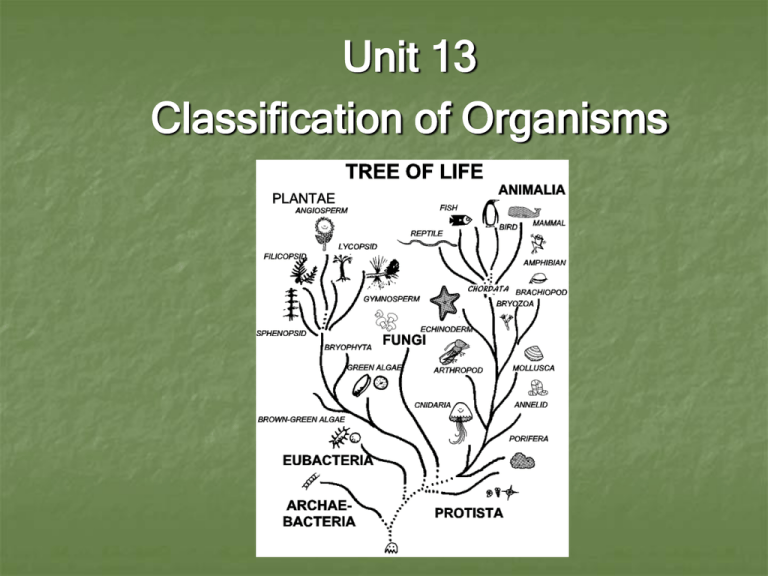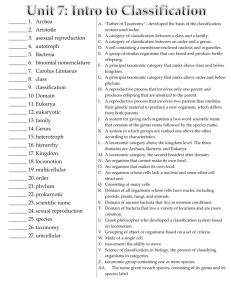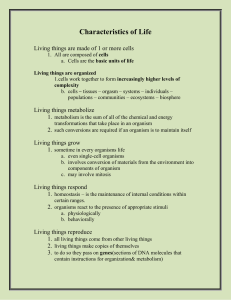Unit 13 Classification of Organisms
advertisement

Unit 13 Classification of Organisms I. Isn’t everything living thing either a plant or an animal? A. Aristotle is credited with the first true classification system. He grouped all living things into two basic groups: plant and animal. OR B Linnaeus further classified plants and animals by dividing them into related groups. He used the Latin language, because Latin was not longer spoken conversationally and thus was less likely to change. 1. He first grouped related organisms. He called this a genus. For example, all of the dog-like creatures were grouped as the genus Canis. 2. He next gave every different type of organism in the group a specific name, which he called specie. For example, the dog became Canis familiaris and the wolf Canis lupus. Notice the genus is capitalized but the specie begins with a lower case letter! Both are italicized or underlined. 3. Thus, every organism was given a twoLoxosceles reclusa word name, the genus and specie. (Brown Recluse) This practice of binomial nomenclature continues today, giving each organism a “scientific name”. 4. The benefit of binomial nomenclature includes eliminating confusion due to What name common names (ex. cottonmouth and do you use water moccasin are actually the same for this animal) and allows scientists around organism? the world to more easily communicate. C. Even after the microbial world was discovered, the two “kingdom” system continued. (Yes, science can be very slow to change.) D. As knowledge of the diversity of organisms increased, Whittaker (in 1969) expanded classification to include five kingdoms. King Phillip Came Over For Green Soup E. The science of classification, taxonomy, now allowed scientists to assign seven levels of taxa to living organisms: 1. The kingdom is the most general of these seven taxa, thus the kingdom would contain the greatest number of organisms. 2. Specie is the most specific of these seven taxa, thus the specie would contain only one type of organism. A specie is defined as a group of organisms which can interbreed and produce fertile offspring. F. Today, we use three domains, which are divided into six kingdoms. These domains are based on new information about possible evolutionary relationships. II. What happens when you find an organism and you are stymied? A. Dichotomous keys are tools that use a series of paired statements and the visible characteristics of the organism. Of course, a dichotomous key is only useful if the organism has already been classified and given a scientific name. 1. Always start at statement 1 (or the beginning point) 2. Decide which path best describes the organism (Statement A or Statement B) 3. Follow that path to find the next choice (Go to …) 4. When you can go no further, you will find the name! B. If the organism has NOT been classified, taxonomists must begin the process of classification. In order to correctly classify an organism, scientists use many modern tools: 1. Morphology describes the physical characteristics of an organism. Typically, this is enough information to place the organism within a domain and kingdom. Example: Presence of a nucleus places the organism in Domain Eukarya 2. DNA and biochemical analysis allow scientists to test less visible, but distinguishing, characteristics. Example: Gram staining a bacteria cell allows scientists to distinguish between archaea and prokarya. Gram-positive anthrax bacteria (purple rods) in cerebrospinal fluid sample. If present, a gram-negative bacterial species would appear pink. (The other cells are white blood cells) Gram-negative E. Coli bacteria. 3. Comparing embryology allows scientists to group organisms that share common fetal development. Example: The diagram below would suggest the last two organisms are most closely related. 4. Evolutionary phylogeny describes the evolutionary relationships between organisms. These relationships are deduced based on shared traits that may have been passed from ancestor to new species. Traits may include physical traits (ex. presence of jaws), or may be genetic traits (shared genes). These relationships can be illustrated in a phylogenetic tree or cladogram: Review Questions 1. Who first officially classified organisms? Aristotle, then Linnaeus created our current system 2. What was the contribution of Linneaus to taxonomy? He grouped related organisms and created binomial nomenclature (every organism has a two word name- genus and species) 3. What are the two parts of a scientific name? Genus and species 4. What are the domains used in the current classification system? Prokarya, Archae, Eukarya Review Questions 5. How many kingdoms are used in the current classification system? Six 6. What is a dichotomous key? A key that uses paired statements and visible characteristics to identify a known organism. 7. What 4 modern tools are used to classify a newly discovered organism? Morphology, biochemical similarities, embryology, and phylogeny (evolutionary relationships) III. Why am I not a fungus? A. Kingdom Bacteria 1. Cellular Structure: Prokaryotic with cell wall, unicellular 2. Metabolism: a. Food getting: Very diverse – some are photosynthetic, some are chemosynthetic and some are heterotrophic, taking in food by active transport. b. Cellular energy: Some are aerobic for the production of ATP, some are anaerobic. WARNING-Mostly X-Rated Imagethrough of 3. Reproduction: asexual Bacteria Sexually Reproducing binary fission; may exchange DNA using a process called conjugation. 4. Ecological/Economic Importance: Bacteria are important to the environment because they drive the nitrogen cycle and are decomposers. Bacteria can be beneficial to humans (ex. useful in making foods such as yogurt) or harmful (ex. some may cause disease such as syphilis) B. Kingdom Archaea (Extreme bacteria!) 1. Cellular Structure: Prokaryotic with cell wall, unicellular (different chemicals in cell wall than Kingdom Bacteria) 2. Metabolism: a.Food getting: Very diverse – some are photosynthetic, some are chemosynthetic and some are heterotrophic, taking in food by active transport. Aerobic = b. Cellular energy: Some are aerobic for Oxygen used the production of ATP, some are Anaerobic = anaerobic. No oxygen used 3. Reproduction: Mostly asexual through binary fission; may exchange DNA using a process called conjugation. 4. Distinguishing habitats: They are all classified as “extremophiles” – they live in extreme environments such as thermal vents, swamps, guts of animals, and areas of high salinity. C. Kingdom Protista 1. Cellular Structure: Eukaryotic (some with cell wall and some without), some are unicellular (amoeba) and some are multicellular (seaweed) 2. Metabolism: a. Food getting: Very diverse – some are photosynthetic (plant-like), and some are heterotrophic (animal-like), taking in food by active transport. b. Cellular energy: All utilize aerobic respiration for the production of ATP. 3. Reproduction: Asexual through binary fission (in animal-like protists) and fragmentation (in plant-like protists). Some may exchange DNA though conjugation (sexual). 4. Ecological/Economic Importance: a. Plant-like protists (commonly called algae) are the primary producers of oxygen used for cellular respiration. They are also the producers that form the base of all aquatic food webs. b. Animal-like protists (commonly called protozoans) are important primary consumers in aquatic food webs. Many protozoans also cause diseases such as malaria. c. A specialized group of protists called slime molds are important decomposers. D. Kingdom Plantae 1. Cellular Structure: Eukaryotic with cell wall, all multicellular 2. Metabolism: a. Food getting: All are photosynthetic (autotrophic). b. Cellular energy: All utilize aerobic respiration for the production of ATP. 3. Reproduction: All reproduce sexually (using sperm and egg or spores); may Each one of these buds can develop into a new plant reproduce asexually (using vegetative next year. In fact a whole row of potato plants can be propagation or good spores) started from just one tuber. 4. Ecological/Economic Importance: Plants are exponentially more complex as compared to algae, but perform many of the same ecological roles (oxygen production, base of food web). Plants are also used for numerous products such as clothing (cotton), paper, medicine (aspirin), and lumber. E. Kingdom Fungi 1. Cellular Structure: Eukaryotic with cell wall, mostly multicellular (mushroom) with some unicellular (yeast) 2. Metabolism: a. Food getting: Heterotrophic with extracellular digestion (fungi secrete digestive enzymes and absorb nutrients across the cell wall) b. Cellular energy: Some utilize aerobic Bird’s respiration Nest Fungifor the production of ATP (mushrooms), some are anaerobic (yeast). 3. Reproduction: May be asexual (budding in yeast and spore production in other fungi), or sexual (spores). 4. Ecological/Economic Importance: Fungi are important decomposers. Fungi can be beneficial to humans (ex. used to make food and alcohol), or harmful (cause diseases such as ring worm and athletes foot) F. Kingdom Animalia 1. Cellular Structure: Eukaryotic with no cell wall, all are multicellular 2. Metabolism: a. Food getting: All are heterotrophic and have diverse methods for acquiring food. b. Cellular energy: All utilize aerobic respiration for the production of ATP but some specialized cells can convert to anaerobic respiration when oxygen is scarce 3. Reproduction: All animals reproduce sexually (egg and sperm), but some simple animals may also reproduce asexually (fragmentation in sponges, regeneration in worms) 4. Ecological/Economic Importance: Animals are important consumers in food webs. Animals may be beneficial to humans (ex. foods) or harmful (ex. worms may cause disease) Review Questions: 1. Which 2 kingdoms contain bacteria? Archaebacteria and Eubactera 2. Which 2 kingdoms are prokaryotic? Kingdom Bacteria and Kingdom Archae 3. The organisms of which kingdom do not have cell walls? Kingdom animalia 4. Name the kingdoms that contain important decomposers. Bacteria and Fungi 5. Name the kingdoms that contain producers. Plantae and Protista 6. Why are you not a fungus? I am not a decomposer, do not get my food through extracellular digestion, and do not reproduce asexually!






